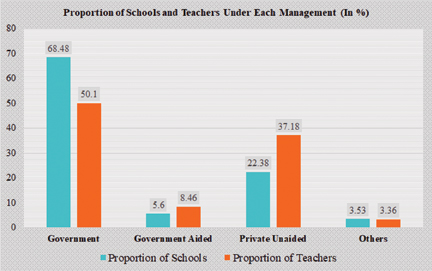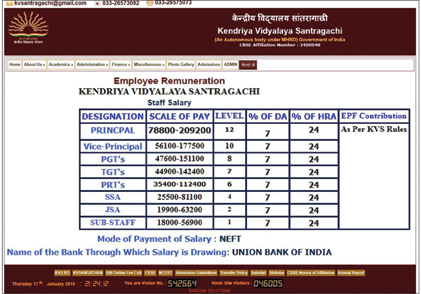Anuradha C
Time and again, the governments in power tend to make dramatic announcements about guaranteeing pay parity to teachers of all private schools in their state. This essentially means private school teachers have the guarantee of equitable pay structure and timely salary payments, just like their counterparts in government-run educational institutions.
On March 30, 2022, a Department of Public Instruction (DPI) circular was released in Karnataka, mandating all 20,581 private unaided schools in the state to pay government prescribed salaries to teachers and administrative staff. This renewed push for pay parity has caused quite a flutter among the teaching staff in various private institutions in the state.
This circular in just a case in point. The larger issue is the on-and-off approach to a serious malaise in the educational world – the insecurities and inequalities faced by the humble private school teacher.
Private vs government schools – a look at some numbers
According to the Unified District Information System for Education Plus (UDISE+) Report for 2019-20, there are a total of 15,07,708 schools in India, out of which 10,32,570 are run by the union government and state governments. 84,362 are government-aided, 3,37,499 are unaided private schools while 53,277 are run by minorities and religious organizations and institutions. This report was published by the Department of School Education & Literacy of the Union Ministry of Education.
This report further states that a total of 96,87,577 teachers work in schools across the country, out of whom 49,38,868 work in government schools, 8,20,301 work in government-aided schools, 36,02,625 work in private schools, and the rest work in other schools.

While private unaided schools comprise 22.38 per cent of the total number of schools in India according to the report, 37.18 per cent of the total number of teachers work in private schools. The majority of schools across the country are run by the union government and state governments. Government schools comprise 68.48 per cent of the schools in India. These schools, however, had only 50.1 per cent of the required teachers. Government-aided schools, which make up 5.6 per cent of the total number of schools, had 8.46 per cent of the total number of teachers, while other schools had 3.36 per cent.
One of the points of summary in the report is that government-run schools have a significantly lesser proportion of teachers when compared to private unaided schools. This is especially true because of the proliferation of private schools in narrow urban pockets where enrolment is high. Whereas vast hinterlands of our country are only catered to by sparsely staffed government schools.
What is the government rule on pay parity?
The Seventh Pay Commission, launched in September 2015 was beneficial to more than 47 lakh employees working in central government and other public units and also teachers of schools, colleges, and universities. In addition to this, about 52 lakh retired pensioners also got a hiked pension structure and other benefits associated with retirement. Not only the salary, other allowances were also hiked under the new pay commission.
Representative Pay Structure after the 7th Pay Commission for teachers in Central Government Schools
This policy reform brought in much needed respectability to a school teacher’s role. This move also managed to stem the exodus of several talented and aspiring teachers from the academic to the corporate world.
However, this applied only to central government educational institutions. Various state governments often follow up the central government’s pay revision announcements with their equivalent revisions. Their pay increments may not match the extent in the central government policy, but still are considered adequate and fair.
Unfortunately, there is no national mandate for private school teachers regarding uniform pay structures prescribed across states. From time to time, state governments try to enforce some pay related regulations across all schools. But such mandates are on paper only and never judiciously followed up.
Let’s take the case of Karnataka once again for a deeper understanding of the problem. The general rule is that teachers of unaided private schools are to be paid and provided benefits at par with government school teachers. This is substantiated by Rule 3(1)(b) of Karnataka Educational Institutions (Certain terms and conditions of service of employees in Private unaided Primary and Secondary and Pre-University educational institutions) Rules, 2005 (the “Rules”).
The circular by the Department of Public Instruction, Karnataka, based on the above rules has said that failure to adhere to this will result in penalty. However, no specification on the type or quantum of penalty was provided. And quite predictably, the rule remained much on paper and did not get enforced adequately on the ground.
The categories of primary school teachers and their respective salaries are in the following range:
Primary School Teacher for Class 1 to 5 – Rs. 13,600 – 26,000
Graduate Primary Teacher for Class 6 to 8 – Rs. 14,550 – 26700
However, based on the Right to Education (RTE) Act, the Department of Public Instructions (DPI) of Karnataka, in April 2019 has stated that all private schools must pay a minimum monthly salary of Rs.25,800/- to primary school teachers, Rs.33,450/- to high school teachers, Rs.27,650/- and Rs.21,400/- to first and second division clerks respectively, and Rs.17,000/- for cleaning and maintenance employees. This dichotomy ostensibly created severe confusion about what must be complied with.
Teachers employed in private schools are entitled to complain to the District Education Regulatory Authority (DERA) if they have any concerns related to payment of salaries in line with DPI’s instruction.
What steps can the teachers and schools take for ensuring pay parity?
The issues of irregular salary payments to private school teachers makes headlines quite often across various states. These problems were greatly amplified during the peak of the pandemic. Since teachers were working from home, there was a notion among school authorities that teachers were having a lighter workload than usual, and thus many schools deferred or diminished their salary payments. The justification given by school managements was that some components of the school fees were being waived off for students, hence the reduced cash inflow. The move was further justified saying teachers now save on travel costs, and can work at their convenience from home. The ed-tech boom also caught up in parallel around the same time, again fueled by the pandemic. So, several teachers started taking up additional employment as online instructors for these ed-tech courses, primarily to offset the income loss.

In one of the private schools in Delhi, for instance, after complaints from teachers over deductions in their salaries since the onset of the pandemic, the zonal deputy director of education had directed a private school to pay the “legitimate salary” within five days or face action. A group of 34 teachers from N K Bagrodia Public School at Rohini Sector 9 had written to the Director of Education in July, and again in August, over 10 per cent deductions in their salaries that had been implemented from April 2020 at the start of the pandemic, which was increased to 15 per cent in April 2021. Other issues they had raised was about non-payment of an annual increment, non-payment of the 7th Central Pay Commission for Children Educational Allowance payable from 2019 onwards, and non-payment of MACP increments since 2018.
The Minimum Wages Act 1948 stipulates the minimum wages payable for certain skilled and unskilled workforce. Teachers are not covered under the Minimum Wages Act. Therefore, it becomes essential to afford teachers some basic standards of social and financial security.
On the flip side, many small and budget private schools are unable to pay the minimum salaries as statutorily prescribed, as this is more than the students’ annual tuition fee and requires a hike of almost 200-300 per cent of the tuition fees. This situation has worsened during the pandemic with schools not being able to re-open and collect the fee. Thousands of teachers lost their jobs.
There is also a counter view that schools should be given autonomy and that the government should not interfere and impose a minimum pay for teachers of private unaided schools.
Despite challenges faced by private educational institutions, the courts of India have in most occasions, ruled in favour of the teachers since for most, this is the primary and sole source of income. With an increase in the cost of living, the teachers have to be protected with the minimum entitlements. The financial security may also ensure better quality of education, benefiting the students and society at large.
It is recommended that educational institutions must draft employee benefit policies in consultation with legal experts who are aware of the local and state specific laws. And teachers must also empower themselves with the knowledge of laws and government mandates in their favour, so that they can make an informed choice while seeking employment in private educational institutions.
The author is an IT industry drop-out after several years of slogging and money-making. She is now working freelance as a corporate technical trainer and content writer. She is hoping to channelize her passion for writing into a satisfying experience for herself and a joyous experience for her readers. She can be reached at anuradhac@gmail.com.
